Description of flavor characteristics of Guji producing area of Huakui coffee beans story of taste characteristics of Sidamo coffee beans
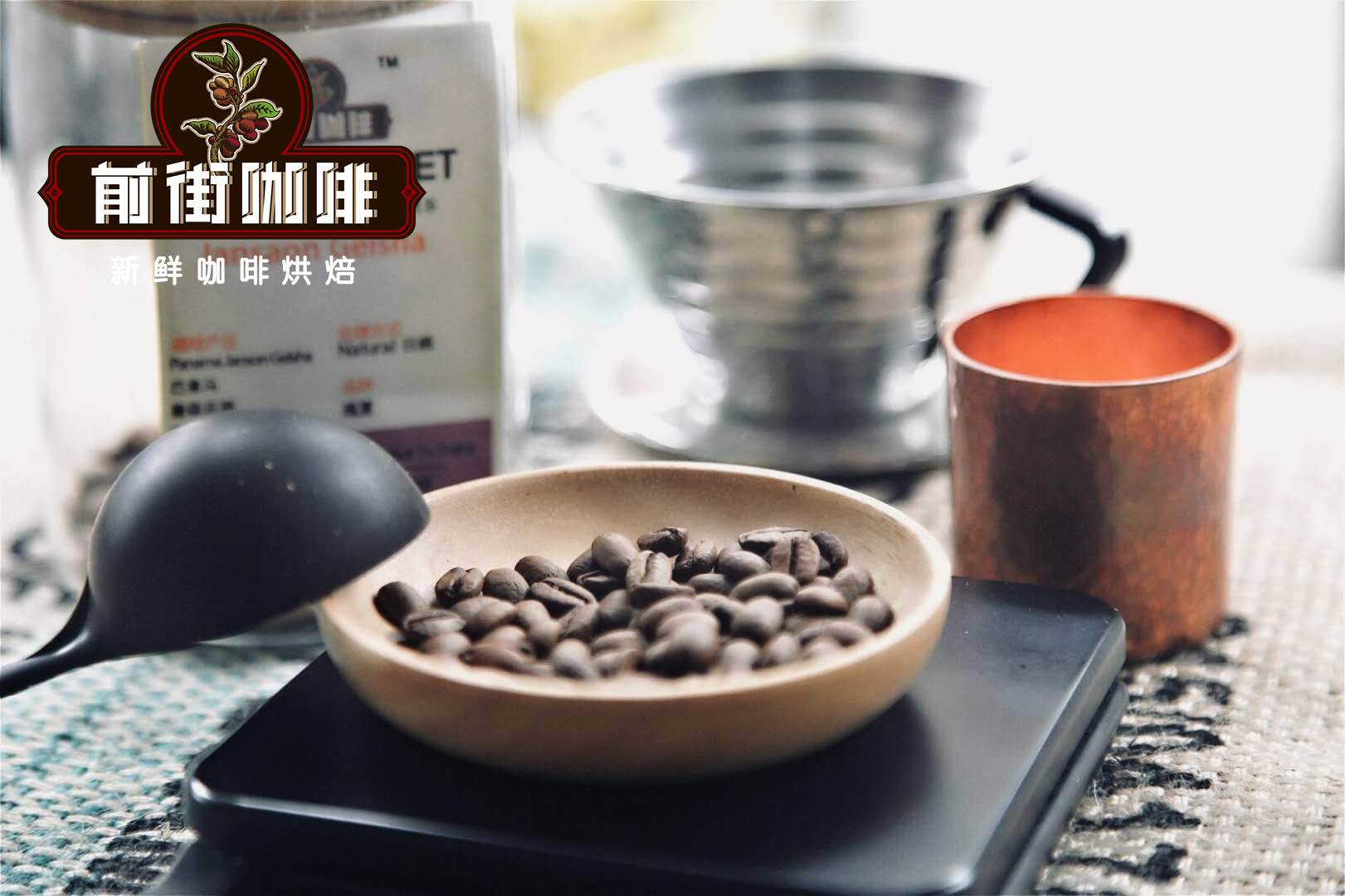
For professional baristas, please follow the coffee workshop (Wechat official account cafe_style)
Ethiopian coffee is mainly divided into two major treatments: sun exposure and water washing. As far as coffee is concerned, Qianjie believes that in addition to varieties, producing areas and planting methods, there is also an important process-coffee raw bean treatment, different treatments will lead to different coffee bean flavor. Ethiopia is recognized as the birthplace of coffee, the coffee produced is also highly respected in the boutique coffee market, and Ethiopian coffee is almost available on the menu of coffee shops around the world. Ethiopia's producing areas vary greatly, and the cup flavor profiles of coffee produced by each producing area, micro-producing area and even farm are also very different, but no matter which producing area, as long as it is Arabica coffee in Ethiopia, many people can't stop. In this article, let's take a look at Qianjie Coffee and let's take a look at the origin of this coffee.
Coffee is the core of Ethiopian culture
In Ethiopia, coffee production is both the labor of most people and an important source of income, and coffee is also integrated into the culture and economy of the country.
Ethiopia is the sixth largest coffee producer in the world. It is reported that 100 million people are directly or indirectly engaged in the coffee industry worldwide in 2018, and Ethiopian coffee workers account for 20% of the 100 million people. In 2017, the country produced about 470000 tons of raw coffee beans, of which about 160000 tons were exported, which means that Ethiopia exports less than half of its total coffee production and consumes the rest domestically.
Coffee has been integrated into the social fabric of Ethiopia for hundreds of years. It is reported that the common word used in local social activities is "buna tetu", which means "drink coffee". One of the most famous Ethiopian proverbs is "buna dabo naw", which means "coffee is our bread".
There are mainly eight major coffee producing areas in Ethiopia: Lekempti, Limu, Illubabor, Djimmah, Harar, Teppi/Bebeka, Sidamo and Yirgacheffe.
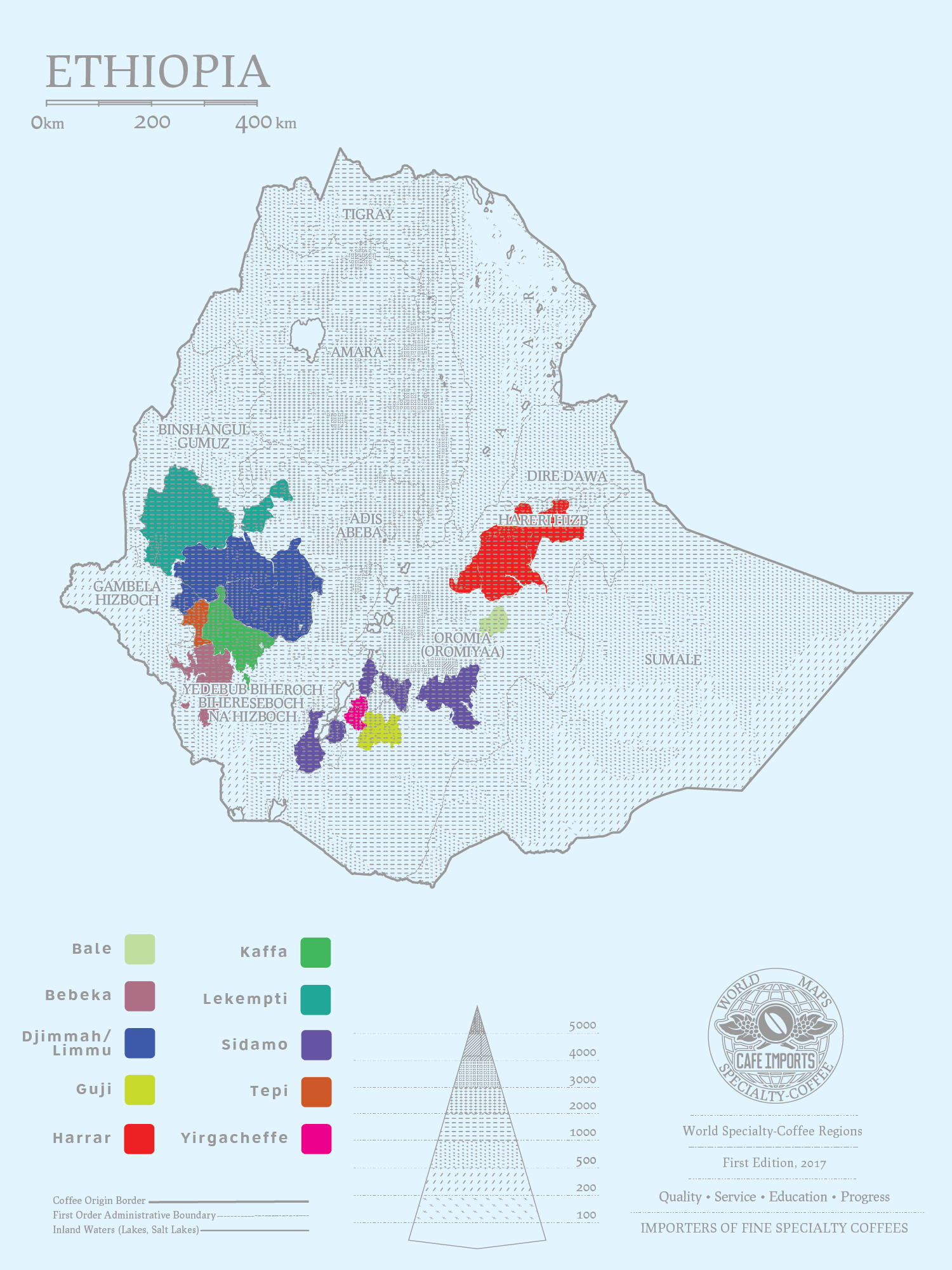
Sidamo
The coffee in Sidamo has a variety of flavors. Different soil types, microclimates and countless native coffee species, towering mountains, highlands, plateaus, valleys and plains, diverse topography, and the geology of the area belongs to nutrient-rich, well-drained volcanic soil. the depth of the soil is nearly two meters, and the surface soil is dark brown or brown. Sidamo, which grows in the southernmost Ethiopian plateau between 4600 and 7200 feet above sea level (Sidamo province), is a famous boutique coffee area in southern Ethiopia, bordering Kenya, southeast of Gemma, just south of the capital, usually sweet and loved by most people, with an annual output of about 225000 bags / 60kg. The biggest advantage of the area is that the soil fertility is maintained through the circulation of organic matter, using the withered leaves of the surrounding trees or the residual roots of the plants as fertilizer. Therefore, the coffee produced in cities and towns has obvious differences and characteristics.
According to the administrative division of Ethiopia, it can be divided into four levels: Region, Zone, Woreda and Kebele, which are equivalent to the provinces, cities, districts and streets of China. Huakui coffee beans come from the city of Guji in Sidamo province, and can be further divided into Hambella Kebele Hambella in Shakisso Woreda Shaquiso. Generally speaking, when it comes to Humbela, most of them are talking about Huakui coffee beans, because Humbela's Huakui coffee beans are so famous.
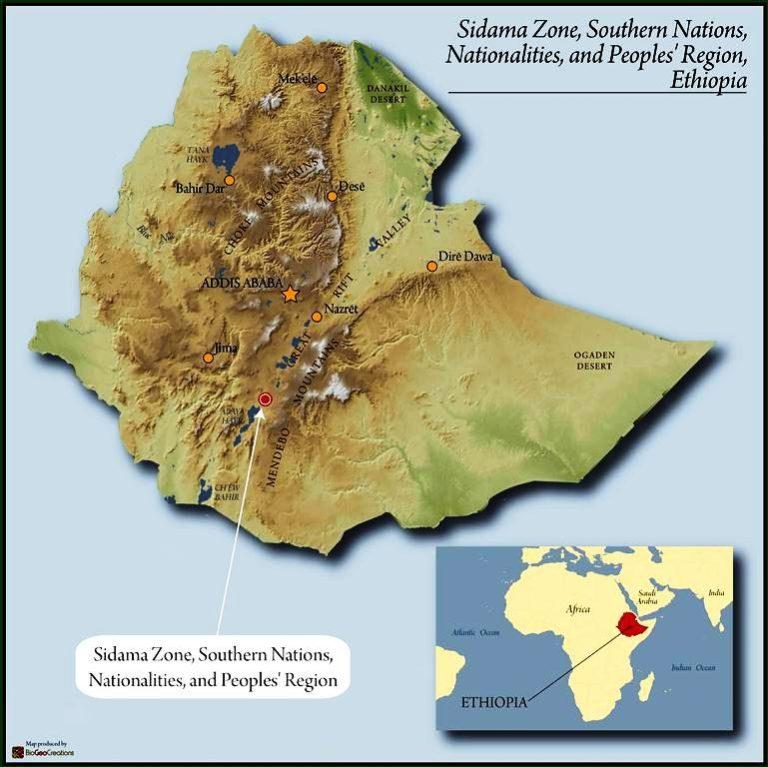
As can be seen from the map of coffee producing areas in Ethiopia, Guji is independent from Sidamo, because of its superior geographical location and unique coffee flavor and elegant demeanor, Guji was independent from Sidamo by ECX (Ethiopia Commodity Exchange) in 2010. Shaqisuo is the most eye-catching micro-producing area in the Guji producing area, with an average elevation of more than 1800 meters.
Introduction of Guji producing area
Guji producing area is located in the southeast of Yejia Sheffield, a well-known producing area.
The raw coffee beans belonging to Oromia Region → Guji Zone belong to the regional type in the division of administrative regions. Just as Yejia Xuefei became well-known after its fame, it became an independent secondary production area of Sidamo (Guji Zone). This batch is made near the town of Dara Woreda in Sidama province. Produced by small coffee farmers in the Sirsa Cooperative (Shilcho Coop). This cooperative was founded in 1976 and is currently a member of SCFCU (Sidama Coffee FarmerCooperative Union), the cooperative federation of Sidama province. SCFCU is a large federation of coffee cooperatives in Ethiopia, which currently has about 46 member cooperatives and is the second largest coffee in Ethiopia.
Qianjie Coffee Sakuran 4.0
Country of origin: Ethiopia
Producing area: Gujimbela producing area of Sidamo
Processing plant: Booku BUKU
Altitude: 2350m
Variety: Dega
Processing method: solarization
Introduction of Humbela producing area
Hambella (commonly translated as Humbela) is located in GUJI, the largest coffee producing region in Ethiopia, and the administration is subordinate to the state of Oromia. The west of Hambella is across the mountain from kochore. The two producing areas are separated by highlands with an elevation of 3200 meters and a width of about 30 kilometers, and are connected with the shakiso,Uraga and Kerchaz producing areas of Guji in the east and south, respectively. It is the highest coffee producing area in Ethiopia (Harrar is the main producing area in Ethiopia).
At present, there are about 20 treatment plants of various sizes in Hambella production area. In 2017, a sun-dried bean from DW's "Buku Abel " processing plant won the Ethiopia National Taste of Harvest Competition. The Chinese raw bean importer named this bean Huakui. At that time, this bean had a strong strawberry and cream aroma. Subsequently, DW Hambella's core production area Dimtu increased from one estate processing plant to four, namely "Buku abel","Buku saysay","Haro soresa" and "Tirtiro Goye", with an annual output of about 1100 tons of coffee. Front Street Coffee also offers coffee products produced by Buku abel.
Buku abel
Huakui treatment plant is located in buku abel village at an altitude of 2200 meters. From the beginning of its cultivation, it has been selected as a noble "family environment"-rich humus reddish brown soil, and given "Enset" tree shade care, so that the flower head receives full sunlight, produces rich flavor without consuming too much nutrients, thus retaining more essence in the coffee fruit. During the harvest season (December-January), its unique growing environment and natural climate created its unique flavor. The red fructose we picked should reach 30 or more before we start sun treatment. In the first two days of the sun, we must ensure the humidity of the red fruit, so that its fructose fully begins to ferment. At the same time, the geographical location of high altitude makes the temperature of the treatment plant at night drop to about 12 degrees Celsius, and it will not produce excessive fermentation smell because of the high temperature. When the temperature is relatively high at noon, we will cover it in time to prevent red fruit sunburn. Select only full-red fruits, fully ripe coffee cherries, all manually picked, African scaffolding drying, limited fruit thickness and 24 hours of uninterrupted regular turnover, to ensure uniform sun and ventilation, more accurately grasp the fermentation degree.
Buku Abel means "NEW" in Ethiopian local language. In this ancient country of more than 2,000 years, with a population of 100 million, the Great Rift Valley has blocked the road to Asia, but new virgin land is still discovered on this plateau from time to time. This is a fairly new development compared to the millennial culture.
Buku Abel is located in southeast Ethiopia, is located in the ancient Ji Hambela region of a very high altitude primitive tribe, population of about 30,000 people, this small village like most Ethiopian coffee gardens, is growing in the wild primitive forest, coffee farmers here for generations of inheritance, and planting native bananas, and local native coffee trees interspersed with banana trees.
Strictly speaking, only sun-tanned coffee from the "Buku Abel" manor and processing plant is called "Sakui Coffee beans". This is why the sun beans from this processing plant were named Sakui 2.0, Sakuran 3.0 and Sakui 3.1 in 2018 and 2019, respectively.
Sakuran, which is produced in the new season in 2020, is named Sakuran 4.0 to distinguish the previous Sakuran. In 2020, as the fourth year of this coffee bean, the area of its production area has expanded several times. Coupled with more scientific planting management, Sakui 4.0 has a better flavor and has been praised by many coffee players. therefore, Qianjie Coffee also purchased this batch of new production season of Sakui 4.0 for roasting and cup testing.
Dega coffee bean variety
This year, Ethiopia held the Cup of Excellence Cup for the first time ("CoE" for short), in which the top 28 coffee varieties were classified in unexpected detail. Dega, ranked 21, has two very different versions of its name. In one version, it is said that Dejia's name comes from a kind of sparkling wood, and the aroma of Dejia when baking is very similar to the burning aroma of this sparkling wood. Another version explains that Dejia "dega" is the Ethiopian root for "highlands and shady places", while Dejia often grows up at high altitudes. It is a pity that Dejia was not among the top 14 in this COE competition, so he did not collect the relevant flavor description. And this time Qianjie Coffee Sakuran 4.0 is the Dega variety of coffee beans.
Raw bean analysis
The Qianjie Coffee purchase of this batch of Sakuran 4.0 will see that Sakui 4.0 is smaller than the other two Sakuran 3.0 beans, this is due to different varieties. Sakui 3.0 is a coffee bean native to Ethiopia, while Sakui 4.0 is a Dega variety. In addition, we can also see that the beans of the two Sakuran 3.0 are relatively average in size, because the coffee beans are picked and screened, while the Sakuran 4.0 is not screened, so the beans appear to be of different sizes.
Coffee treatment
Sun drying is the most traditional treatment. The fruits are naturally dried after harvest. The steps are as follows:
1. After harvest, coffee farmers directly put them in the sun field and dry them in the sun.
2. Timely turning and stirring is needed in the process of sun exposure to avoid uneven drying or fermentation.
3. Dry after a few days
4. Remove the pulp and peel of the dried raw beans with a shelling machine, and take out the raw beans.
Advantages: the pectin of the coffee fruit treated by the sun treatment retains its pectin, while the pectin itself is sweet, and during the sun exposure, the sugar will be transformed into the coffee beans, so the treated coffee will be relatively sweet, rich in taste and layered.
Disadvantages: there will be more defective beans, the appearance of beans is not uniform, it is easy to absorb the peculiar smell and soil smell on the surface.
Baking suggestion
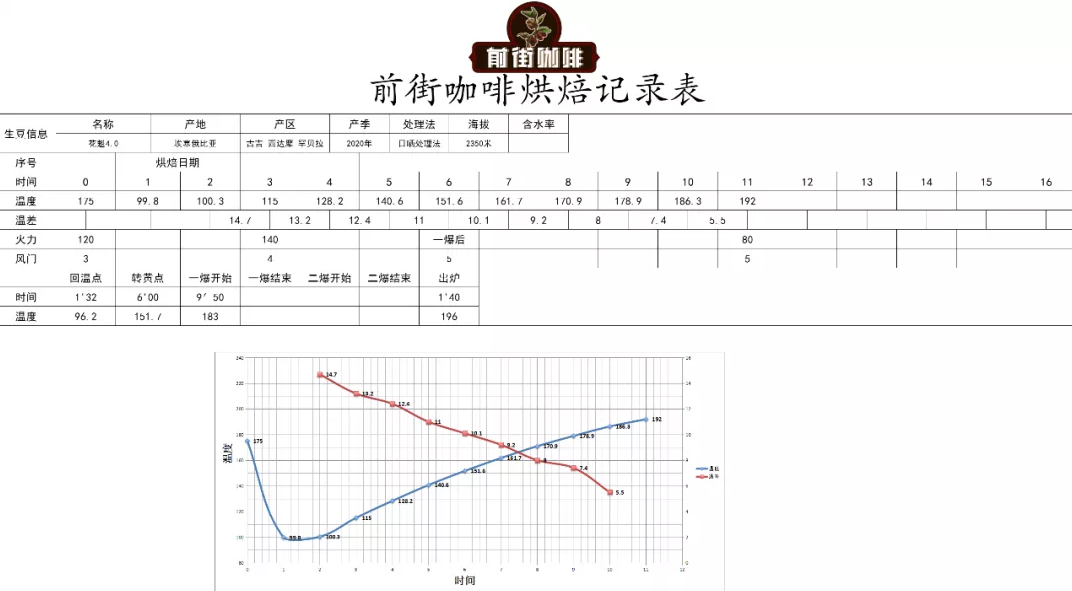
Cup test report
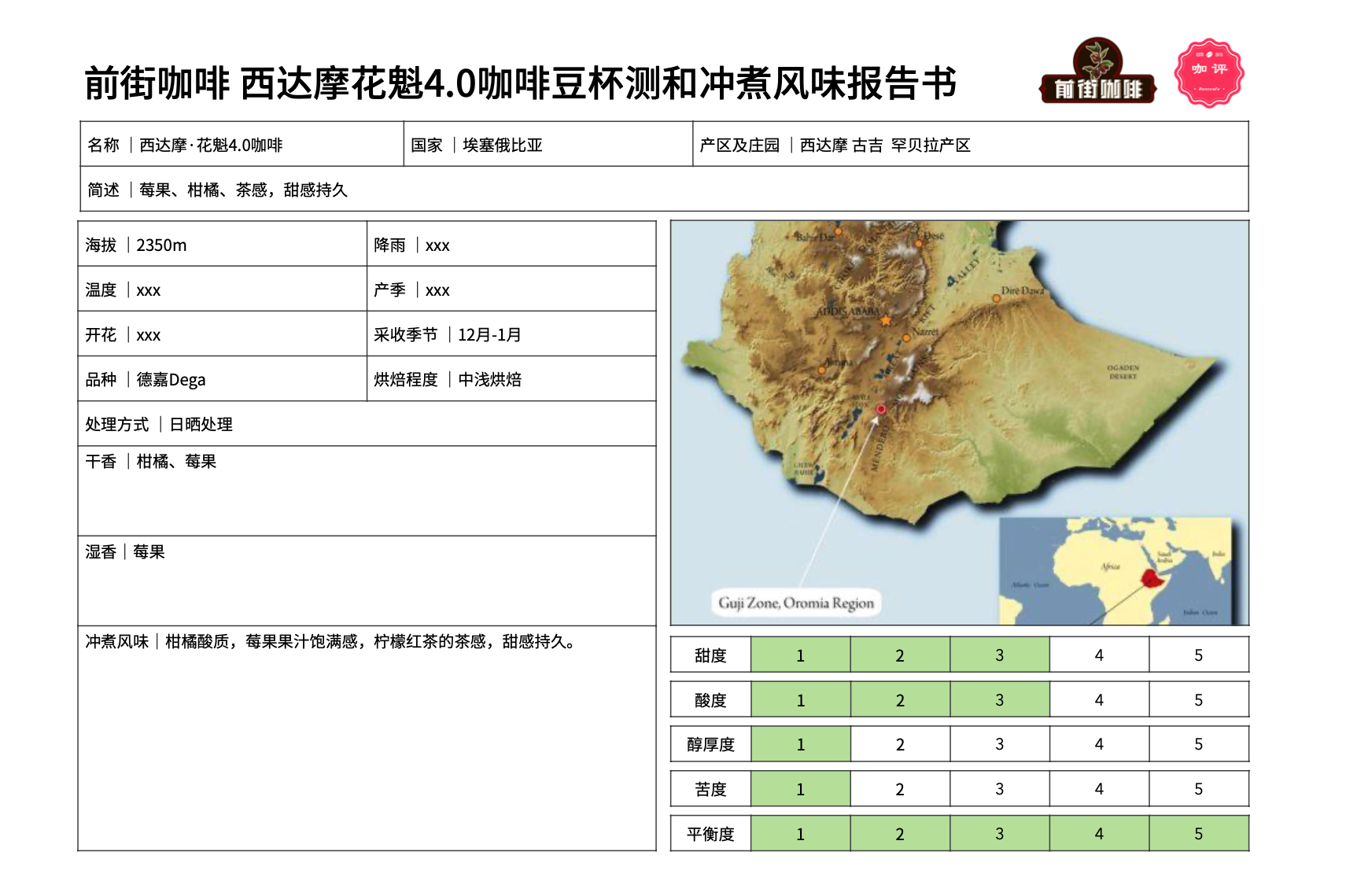
Cooking parameters
Cooking utensils: HARIO V60
Coffee powder: 15g powder
Ratio of powder to water: 1:15
Water temperature: 90 ℃
Degree of grinding: medium and fine grinding (Chinese standard No. 20 screen pass rate 80%)
The ribs of the V60 filter cup are distributed in a curved shape from top to bottom, and the length is different, the exhaust is more smooth and the flow rate is relatively fast when cooking, so this filter cup is generally selected by the way of segmented extraction, one is to slow the flow velocity, the other is to improve the extraction, to a certain extent, it can reduce the lack of extraction caused by fast flow.
Washing and cooking technique
Qianjie coffee is extracted by stages, that is, three-stage water injection.
First water injection: steaming (to help exhaust)
Coffee beans in the roasting process from raw beans to ripe beans will undergo a series of chemical reactions and physical changes, after a certain degree of baking, coffee beans will accumulate a large amount of gas (most of which is carbon dioxide).
Generally speaking, the fresher it is, the closer it is to baking, and the more bubbles usually appear during steaming. Deep-baked beans also release more gas during steaming than shallow baked beans. The coffee beans of Qianjie coffee are freshly roasted, so guests are generally advised to grow beans for three days and let the beans release carbon dioxide first, so that the problem of instability and insufficient extraction can be avoided.
After steaming and discharging the gas, the coffee particles can absorb water evenly, which can make the extraction uniform in the later stage. Good steaming can not only make the coffee powder exhaust quickly, fully and evenly, but also make the coffee powder come into contact with the water quickly, helping the coffee powder to be extracted evenly.
Pay attention to the following four points when steaming:
1. Beat the coffee powder flat before injecting water and steaming.
2. When steaming, water injection should be gentle.
3. In the process of steaming, there is as little extract as possible; when there is too much extract in the kettle, the amount of water injected should be reduced, or attention should be paid to the degree of grinding. If there is too much steaming water, drop a large amount of coffee liquid, the falling water does not stay but directly bring out the external substance of the coffee powder, the miscellaneous taste and astringency of the outer layer of the coffee powder begin to dissolve, so that the coffee is not only light, but also has an exquisite smell. If the amount of stuffy steam is insufficient and no water droplets fall at all, then the coffee powder does not absorb enough water, and some coffee is not exhaust enough, which will cause insufficient extraction.) according to this situation, Qianjie coffee has been steamed many times. It is found that it is more appropriate to inject twice the amount of coffee powder during steaming.
4. The steaming time is about 30 seconds. When the expansion of the coffee powder surface ends, you will see the coffee surface wrinkling, which means that the steaming is complete and you can begin to inject water. In terms of time, coffee is prone to bitterness and astringency if it is steamed for too long. Generally speaking, the end time of steaming varies with each bean, but Qianjie Coffee finds that this is not conducive to novice operation. After all, novices pay attention to standardization and ease of use, so to ensure that coffee beans are still freshly roasted, Qianjie Coffee is recommended for steaming for 30 seconds. Of course, those with experience can adjust the time on their own.
Second water injection
The second water injection starts from the middle, and a small water column is injected into the bottom of the powder layer. in order to concentrate the penetration force of the water column, the range of movement around the circle is small, about the size of an one-dollar coin, and then out. At the beginning of the second water supply, we should pay attention to the amount of water, and try not to exceed the height of the powder layer, that is, when the water column is wound close to the filter paper, the water supply can be stopped.
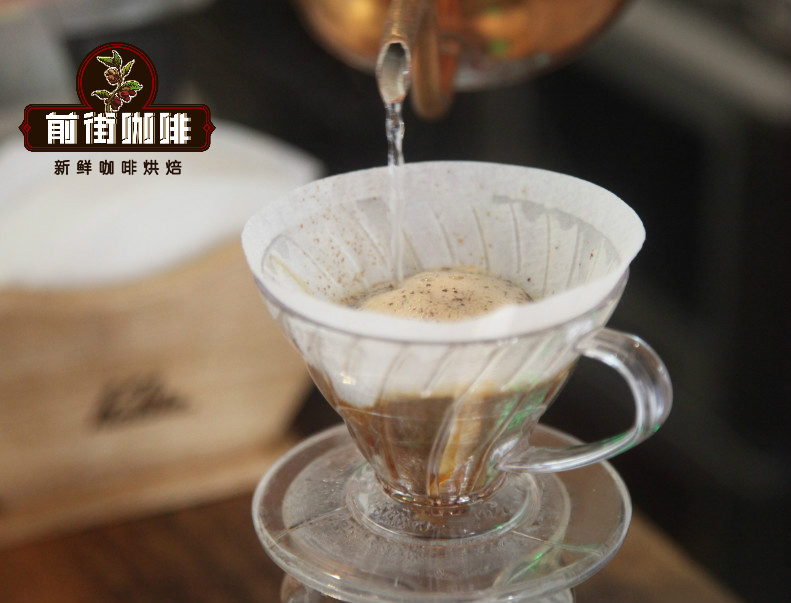
The third water injection
As the thicker powder layer on the edge of the original filter paper becomes heavier because of the draft, and as the water level falls and becomes thinner, the water level drops to half and the third water injection can be carried out.
From the third water supply, it is necessary to observe the extent of the decline of the water level, also from the center of the water supply circle, the amount of water should not exceed the height of the powder layer, then it will also be observed that the proportion of foam has already occupied the surface, and the third water injection will increase the tumbling of coffee granules, let all the deposited particles tumble, and then dissolve the soluble matter.
The rolling particles will start to rest because they stop adding water, and at this time they have to rely on the velocity caused by the falling water level to make the coffee particles produce friction, so once the addition of water stops, the coffee powder particles will sink, causing blockage, so pay special attention to the rhythm of adding water. If the water is cut off too many times, it is tantamount to letting the coffee powder particles soak in the water all the time, which will lead to the astringent and miscellaneous taste of the coffee extract at the end.
Summary:
Qianjie Coffee brews this Huakui 4.0 coffee bean. The overall process is to use twice as much steaming water as coffee powder, that is, 30g water for 30 seconds. When the small flow is injected around the circle to 125g, it is divided into sections, when the water level is about to be exposed to the powder bed, continue to inject water to 225g to stop the water injection, remove the filter cup when the water level is about to be exposed to the powder bed, and the extraction time is 2 minutes.
Flavor description: sour citrus, full berry juice, lemon black tea, long-lasting sweetness.
For more boutique coffee beans, please add private Qianjie coffee on Wechat. WeChat account: kaixinguoguo0925
Important Notice :
前街咖啡 FrontStreet Coffee has moved to new addredd:
FrontStreet Coffee Address: 315,Donghua East Road,GuangZhou
Tel:020 38364473
- Prev
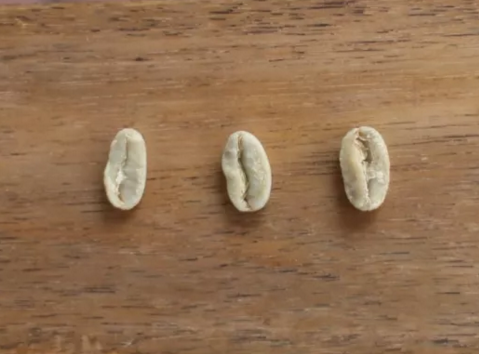
Colombia, Panama geisha introduction, how to hand flush? Practical parameters of hand punching, how much is the ratio of water to powder?
Emerald Manor: the geisha of La Esmeralda became world-famous coffee by accident. Retired Swedish banker Rudolph A. Peterson bought the Jade Manor in Panama to spend his twilight years. Unexpectedly, the coffee trees in the manor bore fruit and were sent to participate in the coffee competition.
- Next

In addition to the variety and environment, there are other reasons why Sunshine Huakui has won the championship for its excellent quality.
Professional barista exchanges please follow the coffee workshop (Wechat official account cafe_style) origin profile: Ethiopia's administrative region is divided into four levels, the order from big to small is Region, Zone, woreda, kebele, most of the raw coffee bean names follow this rule to name, this launch Guji-Shaquiso is located in the southeast of the well-known producing area, in the
Related
- Detailed explanation of Jadeite planting Land in Panamanian Jadeite Manor introduction to the grading system of Jadeite competitive bidding, Red bid, Green bid and Rose Summer
- Story of Coffee planting in Brenka region of Costa Rica Stonehenge Manor anaerobic heavy honey treatment of flavor mouth
- What's on the barrel of Blue Mountain Coffee beans?
- Can American coffee also pull flowers? How to use hot American style to pull out a good-looking pattern?
- Can you make a cold extract with coffee beans? What is the right proportion for cold-extracted coffee formula?
- Indonesian PWN Gold Mandrine Coffee Origin Features Flavor How to Chong? Mandolin coffee is American.
- A brief introduction to the flavor characteristics of Brazilian yellow bourbon coffee beans
- What is the effect of different water quality on the flavor of cold-extracted coffee? What kind of water is best for brewing coffee?
- Why do you think of Rose Summer whenever you mention Panamanian coffee?
- Introduction to the characteristics of authentic blue mountain coffee bean producing areas? What is the CIB Coffee Authority in Jamaica?

